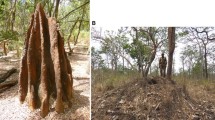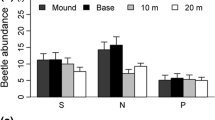Abstract
Termites are more abundant in the warmer lower latitudinal regions of the earth. Within these broad geographic regions, however, the precise nature of the factors influencing termite abundance is poorly understood. In this paper I have examined the abundance of detritivorous, mound-building termites and certain aspects of the climate, soils and vegetation at 14 sites in tropical northeastern Australia. No relationship between termite mound density and the particle-size characteristics of surface soil horizons, plant available phosphorous or rainfall was found. Microbial biomass carbon level of the surface soil was found to have a strong negative relationship with termite mound numbers. The negative interaction between the soil microbial population and termites may be due to the limiting effect of the organic matter processing capacity of the soil microbial population on the success of termites in occupying the decomposer niche in any particular area. Microbial biomass may therefore be a major factor influencing termite abundance in tropical Australian landscapes and elsewhere.
Similar content being viewed by others
References
Amato, M. and J. N. Ladd, 1988. Assay for microbial biomass based on ninhydrin-reactive nitrogen in extracts of fumigated soils.Soil. Biol. Biochem 20:107–114.
Cannon, M. G. and R. J. Coventry, 1989. Soils of the CSIRO Experimental Area, “Redlands”, Balfes Creek, north Queensland. CSIRO Aust. Divnl. Rep. No. 99.
Goodland, R. J. A., 1965. On termitaria in a savanna ecosystem.Canadian J. Zool. 43:641–650.
Holt, J. A., 1997. Biological and chemical properties of soils in semi-arid northeastern Australia: the impact of grazing pressure.Applied Soil Ecology, (in press).
Holt, J. A. and R. J. Coventry, 1982. Occurrence of termites (Isoptera) on cracking clay soils in northeastern Queensland.J. Aust. ent. Soc. 21:135–136.
Holt, J. A. and J. F. Easey, 1993. Numbers and biomass of mound-building termites (Isoptera) in a semi-arid tropical woodland near Charters Towers, North Queensland, Australia.Sociobiology 21:281–286.
Holt, J. A., M. J. Hodgen and D. Lamb, 1990. Soil respiration in the seasonally dry tropics of Australia.Aust. J. Soil Res. 28:737–745.
Holt, J. A., L. N. Robertson and B. J. Radford, 1993. Effects of tillage and residue treatment on the termite population of a central Queensland vertosol.Aust. J. Soil Res. 31:311–317.
Isbell, R. F., 1996. The Australian Soil Classification (CSIRO Publishing, Melbourne).
Isbell, R. F. and G. P. Gillman, 1973. Studies on some deep sandy soils in Cape York Peninsular, North Queensland 1. Morphological and chemical characteristics.Aust. J. Experim. Agric. Anim. Husbandry 13:81–88.
Jones, J. A., 1990. Termites, soil fertility and carbon cycling in dry tropical Africa: a hypothesis.J. Trop. Ecol. 6:291–305.
Lavelle, P., C. Lattaud, D. Trigo and I. Barois, 1995. Mutualism and biodiversity in soils.Plant and Soil 170:23–33.
McIvor, J. G. and C.J. Gardener, 1991. A description of the ECOSSAT experimental site at Cardigan near Charters Towers, north Queensland. CSIRO, Division of Tropical Crops and Pastures, Tropical Agronomy Tech Memo No 68.
Noy-Meir, I., 1974. Desert ecosystems: higher trophic levels.Ann. Rev. Ecol. Syst. 5:195–214.
Pomeroy, D. E., 1978. The abundance of large termite mounds in Uganda in relation to their environment.J. Appl. Ecol. 15:51–63.
Ratcliffe, F. N., F. J. Gay and T. Greaves, 1952. Australian Termites. CSIRO, Melbourne.
Webb, A. A., B. J. Crack and J. Y. Gill, 1977. Studies on gilgaied clay soils (Ug 5.2) of the Highworth Land System in east-central Queensland. 1. Chemical characteristics.Queensl. J. Agric. Anim. Sci. 34:53–65.
Author information
Authors and Affiliations
Rights and permissions
About this article
Cite this article
Holt, J.A. Mound-building termites and soil microbial biomass: An interaction influencing termite abundance. Ins. Soc 43, 427–434 (1996). https://doi.org/10.1007/BF01258415
Issue Date:
DOI: https://doi.org/10.1007/BF01258415




